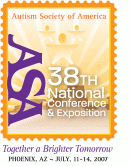 |
The ASA's 38th National Conference on Autism Spectrum Disorders (July 11-14, 2007) of ASAThe Westin Kierland Resort & Spa, Scottsdale, AZ |
| For a complete author index with session numbers, please click here | |
| Friday, July 13, 2007: 3:00 PM-4:15 PM | |||
| Herberger Ballroom 4 & A | |||
| #2556- Mercury and Autism - Toxicity and Treatments* | |||
| This session will review the scientific evidence, pro and con, that suggest that mercury toxicity may be a contributing factor or cause of autism. It appears that many children with autism have a decreased ability to excrete mercury and other toxic metals, resulting in a higher body burden. We will discuss how to reduce exposure to mercury, and review the different treatments available for mercury toxicity. Finally, we will present the results of our latest treatment study with DMSA. | |||
| Presenter: | - James B. Adams is a Professor at Arizona State University, president of the Phoenix Autism Society Chapter, and serves on the Autism Society Board of Directors. He has conducted research on the causes of autism and how to treat it, including nutritional deficiencies and treatments, toxic metals/chelation, and gut dysbiosis. | ||
|
| |||
|
Content: 1) Overview of the symptoms of infantile mercury toxicity, and their similarity to the symptoms of autism, based on the report of the Agency for Toxic Substances and Disease Registry (a branch of the CDC) and the article by Bernard et al in Medical Hypothesis. 2) Overview of the sources of exposure to mercury, including seafood, dental fillings, vaccines, power plants, and other sources. This will include a quantitative comparison of the amount and type of mercury exposure due to each source. 3) Explanation of the critical factors that make some people more sensitive to mercury poisoning, including: A) Antibiotics: A study of rats found that the half-life for excretion of mercury was increased from 10 days to 100 days during antibiotic usage. Our study and others have found that children with autism had a 5x higher exposure to oral antibiotics in early childhood, primarily due to ear infections. B) Low levels of sulfate/glutathione/metallothionein: glutathione and metallathionein are the primary mechanism for the excretion of mercury, and their level is highly dependent on sulfate status, which is very low in children with autism. C) Early exposure: Our study found that mothers of children with autism consumed twice the amount of seafood during pregnancy as the mothers of typical children, and this was confirmed by hair analysis which found twice as much mercury in the hair of mothers of children with autism. 4) Mercury in Baby Hair: A recent study found that children with autism have 1/8 the normal amount of mercury in their baby hair, suggesting an inhibited ability to excrete mercury which is consistent with their high oral antibiotic usage. Also, they found that the severity of autism had a strong inverse correlation with the hair level, such that the children with the lowest levels of mercury in their hair (least excretion) were the most severe. We will also report on our replication study, which we carried out with the help of NIH and researchers at MIT, and which generally supports the Holmes' et al study. 5) Baby Teeth: We will present our pilot study with the Un. of Texas, which evaluated the level of mercury, lead, and zinc in the baby teeth of children with autism vs. controls, and found that children with autism have 2x as much mercury in their baby teeth. We will also present the results of our new, much larger study. 6) Glutathione: We will briefly review the published study by Jill James, which found that children with autism have low levels of glutathione, which is required for excretion of mercury and other toxins, so it strongly suggests that children with autism have a decreased ability to excrete mercury. 7) Thimerosal Studies: We will review the 9 epidemiology studies which investigated the autism-thimerosal connection, including 4 that found a strong connection, one that was inconclusive, and four that failed to find a connection. We will also review the study by Hornig et al. which found that some genetically-susceptible strains of mice were injured by injections of thimerosal at the level used in childhood vaccines. 8) Airborne Mercury: We will discuss two recent studies, one in Texas and one in San Francisco, that found a significant correlation of airborne mercury levels and the incidence of autism in those areas. 9) DMSA challenge results: DMSA is an FDA-approved medication for removing toxic metals from the body. We will present the results of our published study (led by Dr. Jeff Bradstreet) which found that DMSA results in significantly more excretion of heavy metals in children with autism vs controls. This is strong evidence that children with autism have excess amounts of heavy metals trapped in their body. 10) Treatment Reports: We will briefly mention the reports by clinicians on the effect of long-term DMSA treatments in hundreds of children with autism. We will also discuss two newer treatments, DMPS and TTFD, which are becoming more commonly used. 11) Treatment Study: We will report on the results of our randomized, double-blind, placebo-controlled DMSA treatment study. 12) Question/Answer period |
|||
See more of General Submissions
See more of The ASA's 38th National Conference on Autism Spectrum Disorders (July 11-14, 2007)